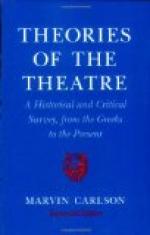Yet this is greatly to Shakespeare’s credit. He was wise enough to feel that what the crowd wanted, both in matter and in form, was what was needed in the greatest drama. In saying that Shakespeare’s mind was commonplace, I meant to tender him the highest praise. In his commonplaceness lies his sanity. He is so greatly usual that he can understand all men and sympathise with them. He is above novelty. His wisdom is greater than the wisdom of the few; he is the heir of all the ages, and draws his wisdom from the general mind of man. And it is largely because of this that he represents ever the ideal of the dramatist. He who would write for the theatre must not despise the crowd.
III
All of the above-mentioned characteristics of theatre audiences, their instinct for contention and for partisanship, their credulity, their sensuousness, their susceptibility to emotional contagion, their incapacity for original thought, their conservatism, and their love of the commonplace, appear in every sort of crowd, as M. Le Bon has proved with ample illustration. It remains for us to notice certain traits in which theatre audiences differ from other kinds of crowds.
In the first place, a theatre audience is composed of individuals more heterogeneous than those that make up a political, or social, or sporting, or religious convocation. The crowd at a foot-ball game, at a church, at a social or political convention, is by its very purpose selective of its elements: it is made up entirely of college-folk, or Presbyterians, or Prohibitionists, or Republicans, as the case may be. But a theatre audience is composed of all sorts and conditions of men. The same theatre in New York contains the rich and the poor, the literate and the illiterate, the old and the young, the native and the naturalised. The same play, therefore, must appeal to all of these. It follows that the dramatist must be broader in his appeal than any other artist. He cannot confine his message to any single caste of society. In the same single work of art he must incorporate elements that will interest all classes of humankind.
Those promising dramatic movements that have confined their appeal to a certain single stratum of society have failed ever, because of this, to achieve the highest excellence. The trouble with Roman comedy is that it was written for an audience composed chiefly of freedmen and slaves. The patrician caste of Rome walked wide of the theatres. Only the dregs of society gathered to applaud the comedies of Plautus and Terence. Hence the oversimplicity of their prologues, and their tedious repetition of the obvious. Hence, also, their vulgarity, their horse-play, their obscenity. Here was fine dramatic genius led astray, because the time was out of joint. Similarly, the trouble with French tragedy, in the classicist period of Corneille and Racine, is that it was written only for the finest caste of society,—the patrician coterie of a patrician cardinal. Hence its over-niceness, and its appeal to the ear rather than to the eye. Terence aimed too low and Racine aimed too high. Each of them, therefore, shot wide of the mark; while Moliere, who wrote at once for patrician and plebeian, scored a hit.




